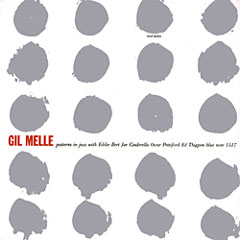June 19, 2008
Patterns in Mono
 A painter as well
as a composer and musician, Gil Melle recorded a handful of albums for Blue Note,
including 1956's Patterns in Jazz, which was one of the earliest Blue Note
recordings made in Rudy Van Gelder's first studio -- his parents' living room in
Hackensack, New Jersey. When I received a test pressing of the LP from Joe Harley and Ron
Rambach at Music Matters,
whose Tiffany-quality Blue Note 45rpm reissues have developed a rabid following, I was
surprised to discover that it was in mono. Music Matters touted its use of stereo master
tapes, pointing out that the mono mixes were often derived from the stereo, so a mono
release seemed unusual.
A painter as well
as a composer and musician, Gil Melle recorded a handful of albums for Blue Note,
including 1956's Patterns in Jazz, which was one of the earliest Blue Note
recordings made in Rudy Van Gelder's first studio -- his parents' living room in
Hackensack, New Jersey. When I received a test pressing of the LP from Joe Harley and Ron
Rambach at Music Matters,
whose Tiffany-quality Blue Note 45rpm reissues have developed a rabid following, I was
surprised to discover that it was in mono. Music Matters touted its use of stereo master
tapes, pointing out that the mono mixes were often derived from the stereo, so a mono
release seemed unusual.
Played with a stereo cartridge, as so many of us
play our mono LPs, Patterns in Jazz [Blue Note/Music Matters MMBLP-1517] sounded
very good. Melle's baritone sax and Eddie Bert's trombone give the music a laid-back feel,
but Melle and the others paint each tune with splashes of instrumental color. This album
reminded me in a broad way of Time Out: The complexity of the music is juxtaposed
with some tasteful, elegant playing.
Patterns in Jazz also reminded me to track
down a mono cartridge. On the subject of true mono playback -- mono recording and
mono cartridge -- Joe Harley warned, "You’ll be hooked, I guarantee, once you
hear a mono record played by a properly designed mono cartridge." Mike Pranka, the US
distributor of Dynavector cartridges, was even more enthusiastic: "I wish all my LPs
were mono now."
The advantage that a mono cartridge has in
playing mono LPs boils down to the movement of the stylus. With mono, side-to-side
movement is all that matters, so the cartridge can be designed to ignore up and down,
often via lower vertical compliance. This helps the stylus ride the groove in the way it
was cut, tracking only the lateral modulations.
With a Dynavector DRT XV-1s Mono mounted on a
second Graham Phantom armwand, Patterns in Jazz positively leaped to life. The
music sounded direct and pure, with overtones more finely drawn, and there was an obvious
decline in noise of all kinds, a byproduct of that reduced vertical compliance. Patterns
in Jazz was literally CD quiet. On sides one and two, I heard not one tick or
pop. Some beat-up mono LPs I have were transformed from dross to nearly demo material.
Everything I was hearing -- and not hearing -- easily justified the cost and trouble of
having a second cartridge.
The Music Matters version of Patterns in Jazz
won't be out until October -- giving you time to begin shopping for a mono cartridge. It
will be followed in November by another mono release: Hank Mobley's Sextet [Blue
Note/Music Matters MMBLP-1568], one of the most coveted Blue Note titles in existence.
While I don't wish that all of my records were mono, I am hooked on 1.0 playback.
Any surprise at finding out that an LP is in mono is now replaced with anticipation and
delight.
...Marc Mickelson
marc@soundstage.com